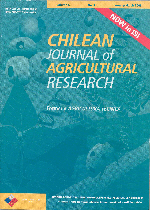
|
Agricultura Técnica
Instituto de Investigaciones Agropecuarias, INIA
ISSN: 0365-2807
EISSN: 0365-2807
Vol. 62, No. 3, 2002, pp. 396-405
|
 Bioline Code: at02038
Bioline Code: at02038
Full paper language: Spanish
Document type: Research Article
Document available free of charge
|
|
|
Agricultura Técnica, Vol. 62, No. 3, 2002, pp. 396-405
| en |
Effects of Restricted Irrigation at Different Stages of Development of Cabernet Sauvignon Grapes on Production and Wine Quality
Ferreyra, Raúl E.; Selles, Gabriel V.; Peralta, Jose A.; Burgos, Loreto R. & Valenzuela, Jorge B.
Abstract
Different water stress treatments were applied to Cabernet
Sauvignon vines (Vitis vinifera L.) during the 1994/95 and 1995/96 seasons
at La Platina Research Center, Santiago (33º34' S. lat; 70º38'
W. long). Treatments T1 and T2 were 100% and 40% of the crop evapotranspiration
(ETc) during the whole season; T3 had no irrigation from budburst to veraison
followed by 100% ETc until harvest; and T4 100% ETc from budburst to veraison
and no irrigation until harvest. Stressed treatments (T2, T3 and T4) significantly
reduced weight and size of berries. Yield was also reduced, mainly when
no water was applied between budburst and veraison (T3). In addition, in
the following season, floral induction was affected by water stress. Wine
color intensity, phenols and anthocyanin concentration were higher in the
stressed treatments, while acidity was increased when water stress was applied
between veraison and harvest. The attributes and global quality of the wine
were favored by water stress, especially after veraison. The stem water
potential (SWP) and plant water stress index (PWSI) were adequate indicators
of plant water status.
Keywords
water stress, grapevine
|
| |
| es |
Efectos de la Restricción del Riego en Distintos Períodos de Desarrollo de la Vid cv. Cabernet Sauvignon Sobre Producción y Calidad del Vino
Ferreyra, Raúl E.; Selles, Gabriel V.; Peralta, Jose A.; Burgos, Loreto R. & Valenzuela, Jorge B.
Resumen
Se aplicaron diferentes tratamientos de estrés hídricos
en vides (Vitis vinifera L.) cv. Cabernet Sauvignon durante las temporada
1994/95 y 1995/96, en el Centro Regional de Investigaciones La Platina ,
Santiago (33º34' lat. Sur; 70º38< long. Oeste). Los tratamientos
T1 y T2 correspondieron a 100% y 40% de evapotranspiración de cultivo
(ETc) durante toda la estación; T3, sin riego desde brotación
a pinta y riego con 100% de ETc hasta la cosecha; T4, riego con 100% de
ETc entre brotación a pinta y suspensión del riego desde pinta
hasta la cosecha. En los tratamientos con estrés (T2, T3 y T4) se redujo
significativamente el peso y tamaño de bayas. También se redujo
el rendimiento, principalmente cuando no se aplicó agua entre el brotación
y pinta (T3). Además, en la temporada siguiente, la inducción
floral fue afectado por el estrés hídrico. La intensidad de color,
la concentración de fenoles y antocianinas fueron mayores en los tratamientos
con restricción del riego, mientras la acidez aumentó cuando el
estrés hídrico fue aplicado entre pinta y cosecha. Los atributos
y la calidad global del vino se vieron favorecidos con una disminución
del aporte hídrico, en especial después de pinta. El potencial
hídrico xilemático (SWP) y el índice de estrés hídrico
del cultivo (PWSI) fueron indicadores adecuados del estado hídrico
de las plantas.
Palabras-clave
estrés hídrico, vid
|
| |
© Copyright 2002 - Instituto de Investigaciones Agropecuarias, INIA (Chile)
Alternative site location: http://www.inia.cl/at/agritec.htm
|
|
